Register of chemical fertiliser sales
The new register for sales of chemical fertiliser will come into effect on 1 January 2023.
This, the Department of Agriculture and Department of Housing says, will provide accurate tracking of fertiliser sales and “will bring a level of regulation to the industry which is needed to ensure chemical fertilisers are used for optimum efficiency”.
It adds that the inter-farm movement of fertilisers and stockpiling of fertiliser does not allow accurate calculation of the chemical fertiliser loadings per farm.
The proposed new register of chemical fertiliser sales will place the responsibility on wholesalers, merchants and distributors of fertilisers to register chemical fertiliser sales against individual farmer’s herd numbers.
This will be reported to the Department of Agriculture, where it will feed into the Department’s analysis of farming activities generally, and more specifically into assessing compliance with the requirements of the good agricultural practice (GAP) regulations.
Inspections and compliance
There are currently 3,400 nitrates-related inspections of farms annually by local authority and Department of Agriculture officials.
The nitrates action plan (NAP) says that compliance with GAP regulations are “generally considered to be low”.
Submissions received and discussions with local authorities pushed for further improvement in compliance levels, adequate resourcing for local authorities and targeting of high-risk areas.
While stronger enforcement powers are not expected, the nitrates expert group will set out reform recommendations to the Minister for Housing.
ASSAP review
The Agricultural Sustainability Support and Advisory Programme (ASSAP) is to be reviewed by a panel of external experts by the end of this year. A further eight advisers will be added to the programme, which aims to improve water quality in primarily nitrogen-sensitive areas of the country.
Slurry storage and movement
The Department said that one of the main non-compliances found on farm inspections is inadequate slurry storage.
Under the next NAP, farmers who do not have the legal minimum slurry storage capacity will not be eligible to apply for a derogation.
There will be a review of the requirement to cover external slurry stores in the interim review.
Slurry dates
The plan outlines new slurry spreading deadlines to reduce the risk of nutrient losses:
From 1 January 2022, all slurry generated on a farm must be spread by 8 October of that year. From 1 January 2023, all slurry generated on a farm must be spread by 1 October of that year. 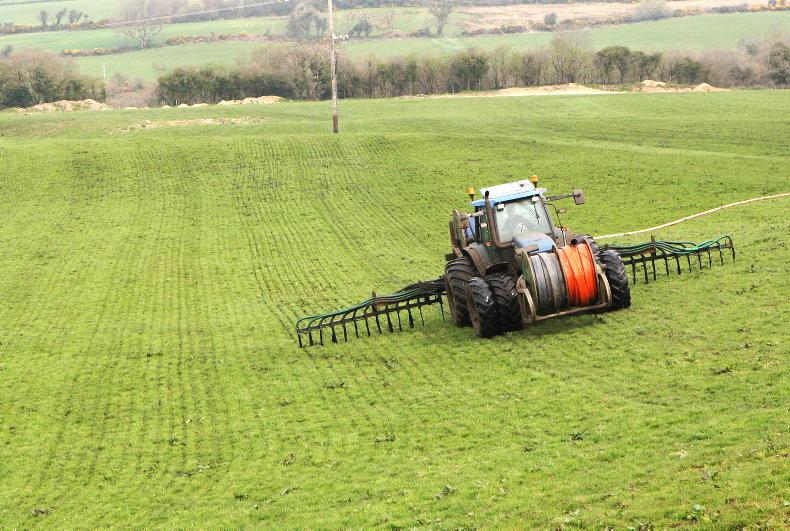
Minister for Housing Darragh O’Brien and Minister for Agriculture Charlie McConalogue are to set out (in 2022) scientific criteria for the safe application of slurry, up to 15 October each year. Where these criteria are strictly met, farmers may be permitted to spread slurry up to the later date of 15 October.
Soiled water
All holdings producing soiled water must have a minimum of four weeks’ storage in place by 31 December 2024.
The spreading of soiled water will be banned for a series of progressively longer periods between now and 2026:
From 1 January 2022 – soiled water spreading will be banned between 21 December and 31 December. From 1 January 2023 – spreading will be banned between 10 December and 31 December. From 1 January 2024 – spreading banned between 1 December and 31 December. From 1 January 2026 onwards, for winter/liquid milk producers, spreading will be banned between 1 December and 31 December. Livestock excretion rates (banding)
New banding of excretion rates for different types of dairy cows will be implemented from 1 January 2023. Each farm’s organic N production will be calculated using the new excretion rate bands on a rolling three-year average.
The first calculation period for farmers is 2020-2022, inclusive.
Chemical fertiliser controls
In 2020, Teagasc updated the Green Book on Major and Micro Nutrient Advice (2016 and 2020). These updated scientific revisions will be included in the next iteration of the technical tables of the regulations, where appropriate.
Additionally, the national nitrogen allowances, as outlined in Table 12 of the regulations, will be reduced by 10% nationally from January 2022, and by a further 5% from 1 January 2024, pending interim review of the programme, scientific advice and water quality trends.
Spreading dates
The ‘closed’ period, when spreading chemical fertilisers on land is banned, is to be extended by 14 days for zones A, B and C.
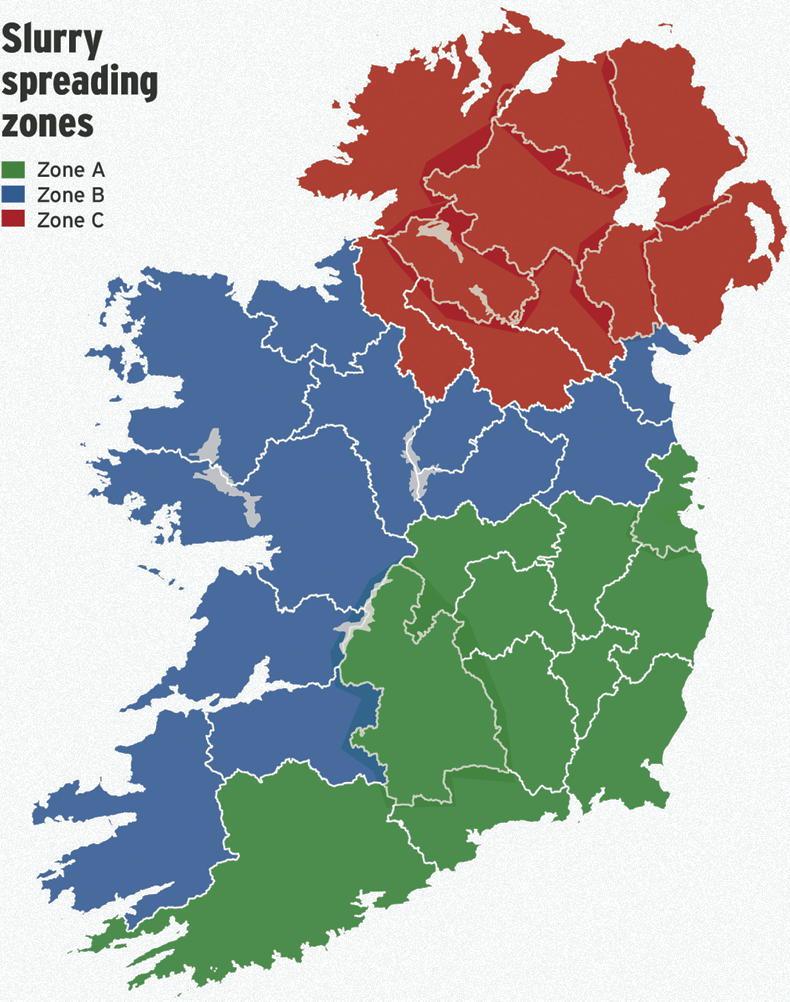
The current slurry spreading zones.
Again, a grace period of 14 days will be allowed in which farmers would be permitted to spread chemical fertiliser, providing they meet scientific criteria for safe application – these criteria will be defined by the Minister in 2022 and will apply from 1 January 2023.
Sewage and industrial sludge
Irish Water, local authorities and the EPA manage and regulate sludge licensing and application.
However, the Department says that there is no integrated approach or data system to identify the loads and spreadlands where sludges are applied.
This is needed to ensure the existing controls are fit for purpose, so the national technical implementation group (NTIG) is to review of the management and oversight of sludges being applied to land and make recommendations.
Phosphorus build-up
The P build-up facility has been reviewed and will remain available to farmers operating above 130kg N/ha.
Green cover on tillage ground
The new NAP will require shallow cultivation of harvested crops to take place within seven days of baling of straw. Where straw is chopped, shallow cultivation or sowing a crop must take place within seven days of harvest.
In all circumstances, shallow cultivation or sowing of a crop must take place within 14 days of harvesting.
Where land is ploughed between 1 July and 30 November, the necessary measures must be taken within 14 days of ploughing to provide for emergence of green cover.
Six metre buffers to protect water bodies must be put in place in critical source areas with late harvested crops such as potatoes, forage maize and late harvested spring cereal crops.
Soil organic matter
From 2022, all soils in the indicative Teagasc/EPA layer for >20% organic matter will be required to be soil tested for organic matter.
Soil tests
From 1 January 2022, all farmers above 170kg N/ha must take soil samples. Where soil samples are not undertaken, Index 4 for Phosphorus will be assumed. From 1 January 2023, all farmers above 130kg N/ha must take soil samples. Where soil samples are not undertaken, Index 4 for Phosphorus will be assumed. All arable land sown from 1 January 2022 must take soil samples.Grazing land and commonage
Commonage land is currently permitted for stocking rate calculations at 170kg N/ha.
Under the new NAP, in order to protect these areas further and the whole farm nutrient planning process, the stocking rate allowance will not exceed 50kg N/ha.
There will be no chemical fertiliser allowance for commonage land.
From 1 January 2025, reduced storage through outwintering will only be applicable to farmers stocked <100kg/ha.
Technical tables
The calculations for nutrient content of livestock manures, including pig slurry and poultry manure, slurry storage requirements and soiled water and slurry production on dairy farms, are all to be reviewed to bring them up-to-date.
Air quality
Compulsory use of low emission slurry spreading (LESS) equipment is to be phased in as follows:
From 1 January 2023, compulsory usage of LESS for all farmers above 150kg livestock N/ha. From 1 January 2024, compulsory usage of LESS for all farmers above 130kg livestock N/ha. From 1 January 2025, compulsory usage of LESS for all farmers above 100kg livestock N/ha. LESS will be mandatory for all pig slurry from 1 January 2023. All organic manures applied to arable (tillage) land must be by LESS or be incorporated within 24 hours of application.
Crude protein in feed
From 1 January 2022, farms with grassland stocking rates of 130kg N/ha from grazing livestock manure or above (prior to export of livestock manure), will only be allowed feed concentrates with maximum crude protein content of 15% to animals grazing on the farm between 1 April and 15 September.
Register of chemical fertiliser sales
The new register for sales of chemical fertiliser will come into effect on 1 January 2023.
This, the Department of Agriculture and Department of Housing says, will provide accurate tracking of fertiliser sales and “will bring a level of regulation to the industry which is needed to ensure chemical fertilisers are used for optimum efficiency”.
It adds that the inter-farm movement of fertilisers and stockpiling of fertiliser does not allow accurate calculation of the chemical fertiliser loadings per farm.
The proposed new register of chemical fertiliser sales will place the responsibility on wholesalers, merchants and distributors of fertilisers to register chemical fertiliser sales against individual farmer’s herd numbers.
This will be reported to the Department of Agriculture, where it will feed into the Department’s analysis of farming activities generally, and more specifically into assessing compliance with the requirements of the good agricultural practice (GAP) regulations.
Inspections and compliance
There are currently 3,400 nitrates-related inspections of farms annually by local authority and Department of Agriculture officials.
The nitrates action plan (NAP) says that compliance with GAP regulations are “generally considered to be low”.
Submissions received and discussions with local authorities pushed for further improvement in compliance levels, adequate resourcing for local authorities and targeting of high-risk areas.
While stronger enforcement powers are not expected, the nitrates expert group will set out reform recommendations to the Minister for Housing.
ASSAP review
The Agricultural Sustainability Support and Advisory Programme (ASSAP) is to be reviewed by a panel of external experts by the end of this year. A further eight advisers will be added to the programme, which aims to improve water quality in primarily nitrogen-sensitive areas of the country.
Slurry storage and movement
The Department said that one of the main non-compliances found on farm inspections is inadequate slurry storage.
Under the next NAP, farmers who do not have the legal minimum slurry storage capacity will not be eligible to apply for a derogation.
There will be a review of the requirement to cover external slurry stores in the interim review.
Slurry dates
The plan outlines new slurry spreading deadlines to reduce the risk of nutrient losses:
From 1 January 2022, all slurry generated on a farm must be spread by 8 October of that year. From 1 January 2023, all slurry generated on a farm must be spread by 1 October of that year. 
Minister for Housing Darragh O’Brien and Minister for Agriculture Charlie McConalogue are to set out (in 2022) scientific criteria for the safe application of slurry, up to 15 October each year. Where these criteria are strictly met, farmers may be permitted to spread slurry up to the later date of 15 October.
Soiled water
All holdings producing soiled water must have a minimum of four weeks’ storage in place by 31 December 2024.
The spreading of soiled water will be banned for a series of progressively longer periods between now and 2026:
From 1 January 2022 – soiled water spreading will be banned between 21 December and 31 December. From 1 January 2023 – spreading will be banned between 10 December and 31 December. From 1 January 2024 – spreading banned between 1 December and 31 December. From 1 January 2026 onwards, for winter/liquid milk producers, spreading will be banned between 1 December and 31 December. Livestock excretion rates (banding)
New banding of excretion rates for different types of dairy cows will be implemented from 1 January 2023. Each farm’s organic N production will be calculated using the new excretion rate bands on a rolling three-year average.
The first calculation period for farmers is 2020-2022, inclusive.
Chemical fertiliser controls
In 2020, Teagasc updated the Green Book on Major and Micro Nutrient Advice (2016 and 2020). These updated scientific revisions will be included in the next iteration of the technical tables of the regulations, where appropriate.
Additionally, the national nitrogen allowances, as outlined in Table 12 of the regulations, will be reduced by 10% nationally from January 2022, and by a further 5% from 1 January 2024, pending interim review of the programme, scientific advice and water quality trends.
Spreading dates
The ‘closed’ period, when spreading chemical fertilisers on land is banned, is to be extended by 14 days for zones A, B and C.

The current slurry spreading zones.
Again, a grace period of 14 days will be allowed in which farmers would be permitted to spread chemical fertiliser, providing they meet scientific criteria for safe application – these criteria will be defined by the Minister in 2022 and will apply from 1 January 2023.
Sewage and industrial sludge
Irish Water, local authorities and the EPA manage and regulate sludge licensing and application.
However, the Department says that there is no integrated approach or data system to identify the loads and spreadlands where sludges are applied.
This is needed to ensure the existing controls are fit for purpose, so the national technical implementation group (NTIG) is to review of the management and oversight of sludges being applied to land and make recommendations.
Phosphorus build-up
The P build-up facility has been reviewed and will remain available to farmers operating above 130kg N/ha.
Green cover on tillage ground
The new NAP will require shallow cultivation of harvested crops to take place within seven days of baling of straw. Where straw is chopped, shallow cultivation or sowing a crop must take place within seven days of harvest.
In all circumstances, shallow cultivation or sowing of a crop must take place within 14 days of harvesting.
Where land is ploughed between 1 July and 30 November, the necessary measures must be taken within 14 days of ploughing to provide for emergence of green cover.
Six metre buffers to protect water bodies must be put in place in critical source areas with late harvested crops such as potatoes, forage maize and late harvested spring cereal crops.
Soil organic matter
From 2022, all soils in the indicative Teagasc/EPA layer for >20% organic matter will be required to be soil tested for organic matter.
Soil tests
From 1 January 2022, all farmers above 170kg N/ha must take soil samples. Where soil samples are not undertaken, Index 4 for Phosphorus will be assumed. From 1 January 2023, all farmers above 130kg N/ha must take soil samples. Where soil samples are not undertaken, Index 4 for Phosphorus will be assumed. All arable land sown from 1 January 2022 must take soil samples.Grazing land and commonage
Commonage land is currently permitted for stocking rate calculations at 170kg N/ha.
Under the new NAP, in order to protect these areas further and the whole farm nutrient planning process, the stocking rate allowance will not exceed 50kg N/ha.
There will be no chemical fertiliser allowance for commonage land.
From 1 January 2025, reduced storage through outwintering will only be applicable to farmers stocked <100kg/ha.
Technical tables
The calculations for nutrient content of livestock manures, including pig slurry and poultry manure, slurry storage requirements and soiled water and slurry production on dairy farms, are all to be reviewed to bring them up-to-date.
Air quality
Compulsory use of low emission slurry spreading (LESS) equipment is to be phased in as follows:
From 1 January 2023, compulsory usage of LESS for all farmers above 150kg livestock N/ha. From 1 January 2024, compulsory usage of LESS for all farmers above 130kg livestock N/ha. From 1 January 2025, compulsory usage of LESS for all farmers above 100kg livestock N/ha. LESS will be mandatory for all pig slurry from 1 January 2023. All organic manures applied to arable (tillage) land must be by LESS or be incorporated within 24 hours of application.
Crude protein in feed
From 1 January 2022, farms with grassland stocking rates of 130kg N/ha from grazing livestock manure or above (prior to export of livestock manure), will only be allowed feed concentrates with maximum crude protein content of 15% to animals grazing on the farm between 1 April and 15 September.






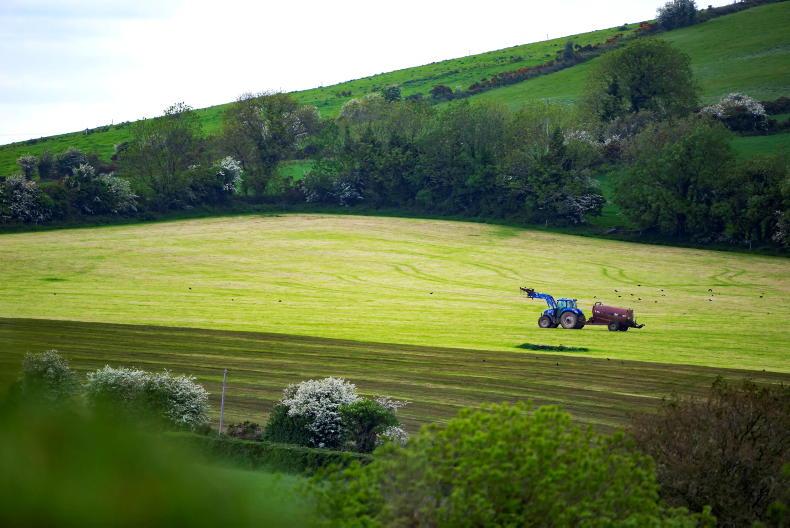
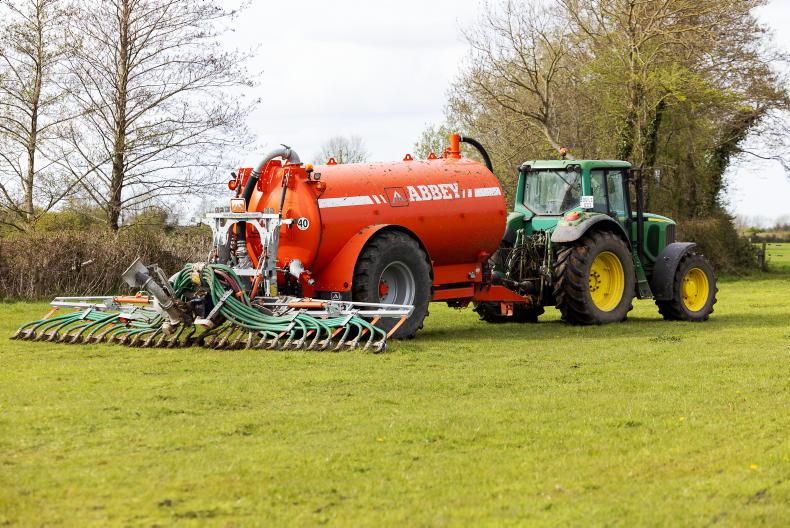
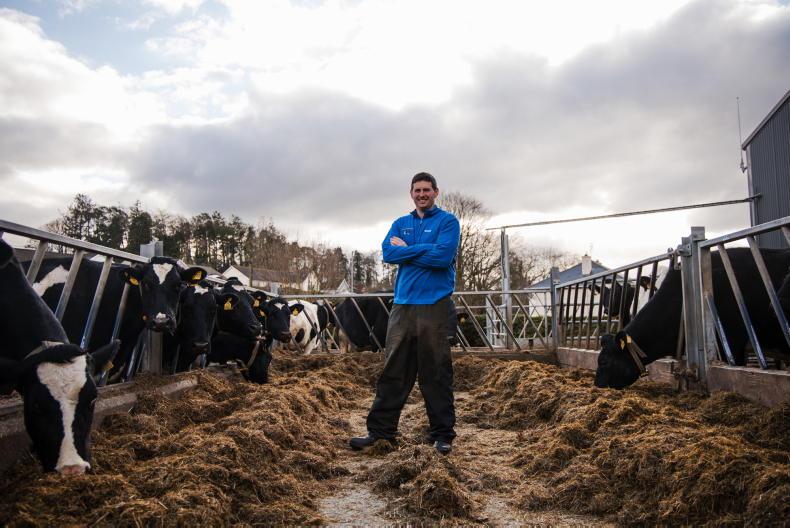
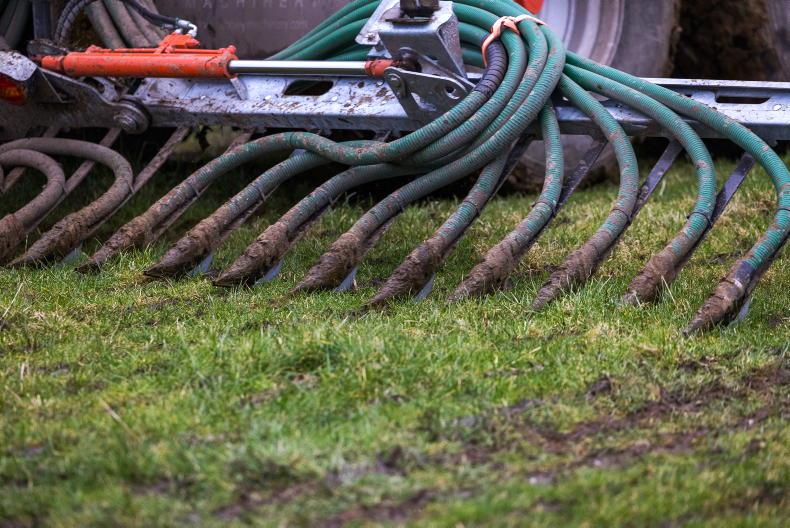
SHARING OPTIONS